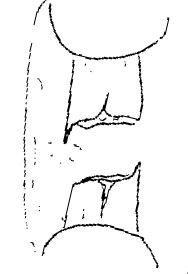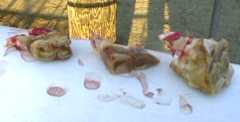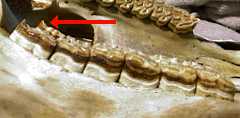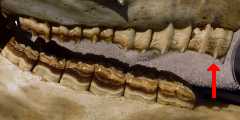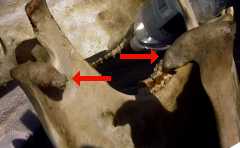Equine Tooth Problems
|
|
| EQUINE TEETH |
|
Horses' teeth grow continuously until some time between the ages of 25 and 30.
Grass, their natural food, contains silica which is an abrasive and which constantly wears
down the horse's teeth. The fibers of heavier grasses require a bit of
grinding on the part of the horse. Additionally the horse reaches down to
bite off grass and then raises his head to chew which changes his jaw
position constantly. A horse living on natural grass will be more likely to
naturally polish off the surfaces of his molars into a level. Thus the horse's
dental apparatus is pretty well adapted to his natural diet.

Here are some views of actual teeth
As these conditions develop the horse's teeth must be once again made level through use of a dental rasp. This process is called "floating," the purpose of which is to rasp off the excess tooth material in order to create a level "table" for the molars to come together. The type of rasp used varies according to the size of the horse's mouth and relative hardness of his teeth. If the conditions are allowed to get to severe, corrective dentistry will be required which involves specialized tools and knowledge. Note: It's not the dentist's intent to make the teeth completely flat. They need some irregularity in order for the horse to grind his food. The table (overall surface where the rows of teeth meet) must be reasonably level overall in order to allow proper jaw movement. In the case of a missing tooth, the opposing tooth will erupt into the space where the missing one should be, causing some problems. The long tooth should be cut or filed to be the same length as the others. If the hooks are too large, the rasp, or float, cannot make it past the hooks, so they will first have to be "rough cut" with a special dental tool. Once the floating is complete, the mouth should be checked to make sure the horse's canines (pointy teeth found behind the incisors in stallions and geldings) are not so long that they press into the opposing gums. If they have grown too long, they will need to be shortened. Some people use hoof nippers to accomplish this task however these teeth can shatter when nipped, causing complications. Grinding or using a dental cutting tool is more appropriate.
Your horse may be showing signs of burgeoning dental problems. Horses who become harder to keep for no apparent reason, who salivate excessively when eating, who eat slowly and with effort, who continuously drop bits of half chewed food and who show unusually coarse manure are prime candidates for a dental inspection. Other behavioral characteristics suggesting tooth problems may include unusual fussing with the bit, avoidance of bit contact, irritation when put into a dropped noseband, head tucking or head tossing, poor self carriage and not wanting to have his face and muzzle handled.
An uneven matching of the molars can put a strain on the temporal mandibular joint, which can be very painful. In humans "TMJ" problems can cause headaches. In horses it can cause them to go off feed or colic. Oftentimes mysterious colics which have no apparent cause can be traced back to dental problems. Hooks on the far back of the molars can prevent the horse's jaw from relaxing and moving forward when the rider asks him to round up, especially if he's wearing a tight dropped noseband and can't open his mouth to relieve the pressure. This situation can also be painful and result in the horse displaying unusual head movements or being unable to sustain a comfortable frame. Additionally, young horses will often experience discomfort when shedding their deciduous (baby) teeth. Lumps will often appear under the jawbones while the new teeth are trying to erupt and sometimes the horse can benefit from some human assistance in removing the old baby tooth "caps".
Horses who have had significant dental malalignment can become very sore in the jaw after floating. The temporal mandibular joint, ligaments and support muscles will have adjusted to perhaps years of operating in an unnatural position. When the bite is corrected, the joint should return to a normal position in its socket which can temporarily cause a strain and pain to modified tissues. The horse may have difficulty chewing and grinding his food, in which case appropriate doses of phenobutezol (bute) should be administered and the horse supplemented with ground feed until the joint stabilizes and the pain subsides. This discomfort is not usually indicative of improper dental work and should subside in a few days and the horse should benefit from improved dental (chewing) function.
Most equine dentistry involves prevention. If your horse's teeth are regularly cared for, the maintenance process will not be overwhelming and you should be able to avoid most dental or health complications. Depending on your horse's diet, hardness of teeth and jaw alignment, he may need floating on an annual basis or perhaps he could last years between floating. By keeping an eye on your horse's teeth, you can determine how quickly your horse's dental surfaces are changing and get them cared for before complications arise. Part of prevention is knowing whom to call when you need equine dental care. Some veterinary teaching hospitals do not teach tooth floating and your particular veterinarian may or may not be schooled and experienced in this process or in the art of realigning a maloccluded mouth. If (s)he is not, you may need to locate an equine dentist in your area.
Press Back to return to the page which brought you hereReturn to KBR Horse Health SectionReturn to KBR Training SectionGo to KBR Safety SectionReturn to KBR World of Wild Horses & BurrosGo To |

